Hover Strolling Fishing for Bass
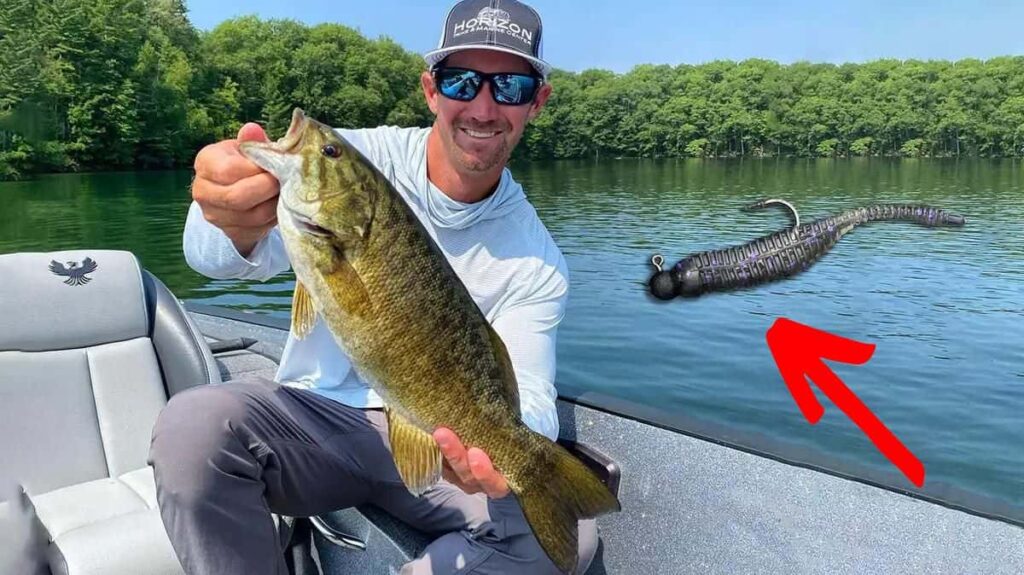
This simple technique has taken the fishing industry by storm.
It’s simple, effective, a little confusing, and a must have in your angling arsenal.
I’m talking about hover strolling, and it can catch you a ton of bass.
What is Hover Strolling?
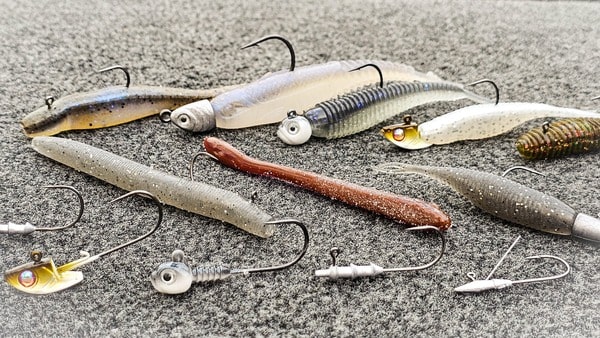
Hover strolling is a finesse bass fishing technique and rig that has taken the industry by storm recently.
Although it is not a new technique, with the recent advancements in forward facing sonar, hover strolling has shot off like a rocket and has become one of the most popular techniques in all of bass fishing.
Now, although forward facing sonar gave it a huge boost, do not make the mistake of thinking that hover strolling can only be used in combination with electronics.
We’ll get more into it’s versatility, but don’t think that if you don’t have FFS that you can’t fish this setup.
Quick Setup Breakdown
The technique itself is very simple. Just take a very light weight jig head (or hover rig) and pair it with a minnow or fluke style soft plastic.
You don’t want a paddle or curl tail bait. The effectiveness of hover strolling comes with the sleek, actionless tail.
Typically this plastic will be a smaller bait than most flukes. 3-4 inches is the most popular sized bait for hover strolling.
For the jig head or hover rig, I like a 1/32 oz in super shallow water and a 1/16 oz if I’m fishing from a boat and trying to cover a bit more water.
You want your weight to be as light as you can possibly get away with.
The Two Jig Head Styles
There are two styles of jig heads that you can use with this technique.
The classic style of jig head and the specialized hover rig style.
Classic Jig Head
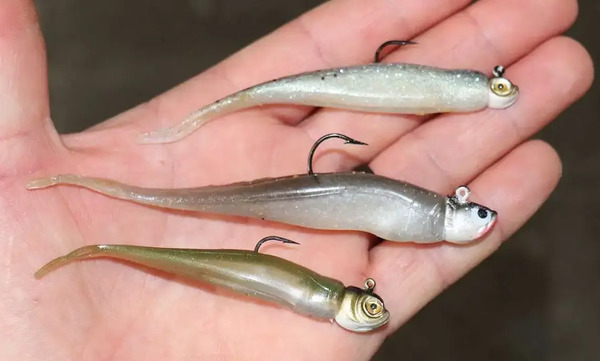
The classic ball head or baitfish head jig is still the most popular hover strolling choice.
It’s easy to use and everyone knows exactly how to rig baits up on it.
Just make sure you use a jig head that has a 90 degree line tie like the ones you see above.
Special Hover Rig Head
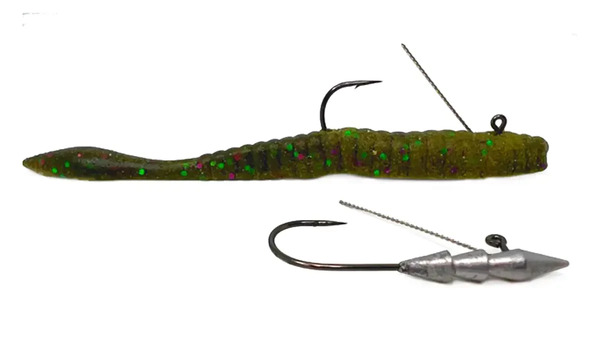
This jig head was made specifically for hover strolling.
This style jig head allows you to hide the weight inside the soft plastic, giving it a bit more natural profile and feel.
Also, having the line tie farther back in the bait keeps it more horizontal as it comes through the water.
Hover Strolling vs Mid Strolling vs Damiki Rig
So there is a bit of confusion around this technique. More accurately, there is a bunch of different names for essentially the same technique.
Hover strolling, mid strolling, moping, and Damiki rig fishing are most common names.
Although they are all essentially the same, I feel like hover strolling is a bit more unique.
I feel like hover strolling is really all about using very light weights, light line, and small baits.
It is an ultra finesse, slow, and subtle style of fishing. The Damiki rig especially, usually uses a bit heavier jig heads, bigger hooks, and full sized fluke baits.
So if you hear guys talking about these techniques, they are all pretty much the same, although some might lean a little lighter or heavier on the gear.
Benefits of Hover Strolling
Ultra Finesse
Hover strolling is incredibly finesse. Think of it as a finesse swimbait, except with a lighter jig head and without a paddling tail.
Super light, super subtle, and super natural. With this technique, you are imitating smaller baitfish in the middle of the water column.
A lost minnow, shad, baby bass, or bluegill that is just too easy of a meal for bass to decline.
Easy to Fish
In a second I’ll go over the actual retrieval technique for this rig, but as you can imagine, it’s very easy. It’s just a jig head and minnow bait.
You don’t want it to have too much action, so you don’t need to worry about fishing it perfectly.
It’s kind of like a ned rig, but suspended in the middle of the water column. It’s just super easy to fish.
Minimal Tackle
Nobody likes complicated rigs that require a bunch or different weights or soft plastics or specialized hooks.
I think it’s fare to say that everyone prefers simplicity when they can get it.
All you need for hover strolling is a jig head and a minnow. And you probably already have those.
Hyper Realistic
This goes back to the finesse side of things. Hover strolling is incredibly realistic.
You have a very realistic minnow style bait with a very light weight.
It’s action is very subtle and natural, all while looking just like a baitfish from the nose to the straight tail.
If you’ve ever seen small baitfish cruising along in the water, they don’t have erratic side to side movements or a thumping paddle tail.
They just kind of glide through the water with the occasional dart forward. That is the presentation that hover strolling mimics.
Retrieval Technique
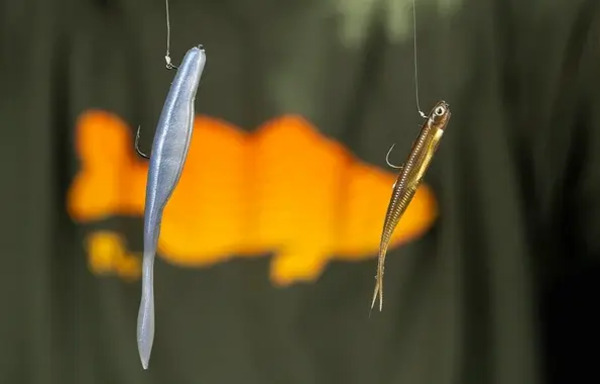
As you can probably guess, it is super easy to retrieve a hover rig. Once it hits the water, let it very slowly sink down to whatever depth you want it at.
In shallow water, you can even keep it right up on the surface if you want.
They slowly start reeling back in while ever so slightly shaking your rod tip.
That shake will cause the minnow to sway and rock back and forth, almost like a finesse scrounger head.
Personally, I like to retrieve like this: 2 seconds with a straight reel, then 2 seconds with the reel and shake.
Then repeat that cycle all the way back in. If you see a bass trailing behind your bait for a few seconds, give it a bit of a pop or twitch and it will jump to the side erratically.
The bass will think it’s trying to escape and quickly gulp it up.
When to Hover Stroll:
Pressured Water
There are certain bodies of water and certain times of year when high pressure is the number one issue with the bass fishing.
Tons of guys are out fishing. The bass do not like this pressure at all.
Finesse is usually the best option for fishing when there is tons of pressure on your water.
And hover strolling is super finesse and super natural.
Clear Water
The hover technique has almost no vibration, very little water displacement, and no sound.
This means it is almost exclusively visual presentation. And for visual presentations, bass need to be able to clearly see the bait.
In muddy water, it’s going to be nearly impossible for bass to track down this bait.
So stick to clear water lakes and ponds when hover strolling.
Winter
Strolling techniques have become a staple of winter time bass fishing.
It is subtle, slow, realistic, and easy for the lethargic bass to eat. There is one difference I make when fishing this technique in the winter.
I will go heavier with my jig heads. Since the winter time bass are typically out in deeper water, I have to go heavier to get my bait down there.
A 1/8 oz or even 1/4 oz work great for the winter months.
Where to Hover Stroll:
Suspended Bass
This is the reason that FFS (forward facing sonar) was the catalyst for the rapid popularity of the hover fishing technique.
Forward facing sonar allows you to clearly see and target suspended bass. And when anglers started hover strolling for these bass, it quickly blew up.
The slow, subtle minnow just gliding through the middle of the water is incredible natural and almost impossible for the suspended bass to turn down.
Shallow Water
Now deep strolling and Damiki fishing are slightly different. But when you are hover strolling, shallow water is key.
The rig itself is super light weight and sinks incredibly slowly. So you can’t really fish it out deep with the same effectiveness.
I like to fish it very shallow (about 1-4 feet) and slowly work it in the middle of the water column. Trust me, it works like crazy.
Ponds
Ponds are pretty much always very shallow all the way around. So the entire pond is perfect conditions for a slow moving hover rig.
I have tons of success year round with this technique when fishing in ponds.
Especially because ponds are very often highly pressured, you need something like the hover rig to catch highly pressured, shallow water bass.
Gear Setup
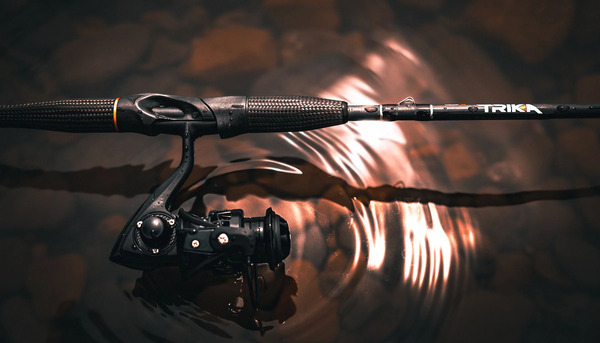
Your going to be using a light spinning combo with light line. I like a medium or medium light action spinning rod.
That way I can still cast the light bait far, and have a bit more fun when fighting the fish.
For the line, 6-10 lb line is about perfect. Some of the Japanese anglers go all the way down to 4 lb test, but that’s just too light for me.
Anything over 10 lb test it going to be difficult to cast and you will lose much of stealth of a lighter line.
Fluorocarbon is certainly the best line option. It is nearly invisible and will give you better hook sets with the smaller hooks.
But if you don’t want to spend the money on fluoro, monofilament and copolymer work great too.
Reeling this In
Hover strolling has revolutionized the bass fishing scene with its simplicity, effectiveness, and versatility.
This ultra-finesse technique, utilizing a light jig head paired with a minnow or fluke-style soft plastic, excels in pressured and clear waters, particularly in shallow and pond environments.
Its subtle, natural presentation makes it irresistible to bass, especially during challenging fishing conditions.
Whether you have advanced electronics or not, hover strolling is a must-have in your angling arsenal, offering an easy-to-fish, hyper-realistic bait option that can enhance your fishing success year-round.






